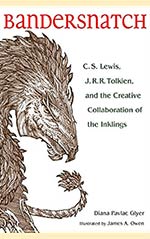
![]() gallyangel
gallyangel
2/12/2016
![]()
I've got to start with a misconception that people who don't know artists or other creative people often have. Many people think that the creative process starts and ends in the space between the artist and the work. That is, in that space between the blank page and the writer, the blank canvas and the painter, or the raw stone and the sculptor. This is only partially true and this partial truth gives rise to the myth, yes Myth, of the writer in a lonely garret, the Eiffel Tower in the background, out the window. Yes, in that space is where everything collides in the struggle right then and there to create, but any artist will tell you that this point is only 50% of the process. (Some say more, some say less.) There is a wholly different side to the creative process which those who don't know artists, know nothing about.
That is Bandersnatch: the other side where creativity is forged in the crucible of fellowship.
In terms of the 20th century, the Inklings, this select group of men, who met, talked, and critiqued each others work, has now become The Example for how a fellowship is supposed to work. Even Paris of Hemingway's lost generation, with their salons, and creative minds from far more disciples, seems now a pale second place.
Bandersnatch takes us into this crucible, trying to reconstruct from a fly-on-the-wall perspective this extraordinary time and place. Glyer is concerned with two fundamental questions: What did they talk about when they discussed the various works in progress? and What difference did it make within the books they were writing?
These are Simple but seemingly unanswerable questions. Until now, of course. It is positively amazing what a determined scholar can find, especially going into a headwind of opinion from friends, mentors, teachers, that these questions Can Not be answered, so one shouldn't waste ones time trying.
Thank goodness she didn't listen to those little minds. The end result was the book The Company They Keep: Lewis, Tolkien as Writers in Community. Bandersnatch then is not the Good Parts version, the dumbed down for a general audience version, nor a more intimate treatment with the author as narrator version, although all three facets do come into play. Think of Bandersnatch as a distillation with an eye on bringing the practice, that is, the wisdom of The Inklings, into our own lives as creative people.
What did they talk about? What difference did it make? The answer is everything and the other answer is that it made a huge difference. You'll have to get the details from the book!
For me, the book highlighted not just the critique part of fellowship, but also the resonating aspect, that is, someone who gets it like you get it. If, say, two anime Otaku (obsessed fans of Japanese animation) get together and one of them says "SAO" that's all they need to engage in a 40 minute conversation concerning the minutia of "SAO" that is as incomprehensible to an outsider as if the outsider was listening to two astrophysicists. From what Glyer has gleamed from The Inklings and from a lot of current research and thought on the subject, this resonating aspect by itself is huge, in terms of creativity.
Glyer goes on to illuminate a half dozen other forms of feedback within the fellowship and what effect it had on the individual writers and their work. She also, fortunately or unfortunately, illuminates what ultimately sunk their ship: what went wrong and why it was their undoing. This, of course, should be a lesson for our own creative process.
If you are a Lewis or Tolkien fan, what are you waiting for? Go and get this book. If you don't care for those two but the issues surrounding creativity, or writers in general are of interest, this book offers plenty for you as well.
Highly recommended.